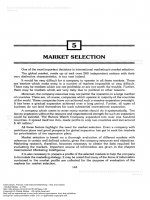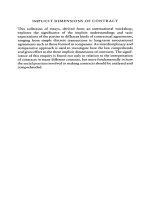International marketing strategy and theory ch03
Bạn đang xem bản rút gọn của tài liệu. Xem và tải ngay bản đầy đủ của tài liệu tại đây (51.16 KB, 12 trang )
Chapter 3
Trade Distortions and
Marketing Barriers
Chapter Outline
Protection
of Local Industries
Government: A Contribution to Protectionism
Marketing Barriers: Tariffs
Marketing Barriers: Nontariff Barriers
Private Barriers
World Trade Organization (WTO)
Preferential Systems
Protection of Local Industry
Keeping
Money at Home
Reducing Unemployment
Equalizing Cost and Price
Enhancing National Security
Protecting Infant Industry
Marketing Barriers: Tariffs
Direction:
Import and Export Tariffs
Purpose: Protective and Revenue Tariffs
Lengths: Tariff Surcharge versus
Countervailing Duty
Rates: Specific, Ad Valorem, and Combined
Distribution Point: Distribution and
Consumption Taxes
Marketing Barriers: Nontariff Barriers
Government
Participation in Trade
- Administrative Guidance
- Government Procurement and State Trading
- Subsidies
Marketing Barriers: Nontariff Barriers
Customs
-
and Entry Procedures
Classification
Valuation
Documentation
License or Permit
Inspection
Health and Safety Regulations
Marketing Barriers: Nontariff Barriers
Product
-
Requirements
Product Standards
Packaging, Labeling, and Marking
Product Testing
Product Specifications
Marketing Barriers: Nontariff Barriers
Quotas
- Absolute Quotas
- Tariff Quotas
- Voluntary Quotas
Marketing Barriers: Nontariff Barriers
Financial
-
Control
Exchange Control
Multiple Exchange Rates
Prior Import Deposits and Credit Restrictions
Profit Remittance Restrictions
Private Barriers
Affiliated
firms' business practices
Cooperative business groups
- keiretsu
- chaebol
The World Trade Organization (WTO)
Goal:
broad, multilateral, and free worldwide
system of trading
Most Favored Nation (MFN) Principle
Normal Trade Relations (NTR) Principle
GSP
Generalized
System of Preferences (GSP)
Preferential system
Aiding economic development of developing
countries
Allowing duty-free entry of products









